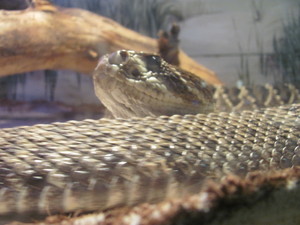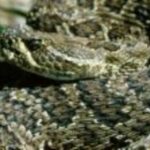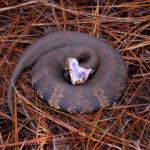In far West Texas Rattlesnakes are a common factor along with the rocks and cacti. One of the most used terms for Mothers is to tell their children as they go out to play is watch out for a “rattler”.
Rattlesnakes in West Texas sort of hibernate in the winter months if it is cold enough. Since they are cold blooded they really aren’t hibernating just can’t get around too good when it is cold. But when the spring season begins they get warmed up and are more active. They crawl out from under rocks and vacant buildings where they have built their dens during the cold weather. Dens can have lots of snakes in them. Demolition in West Texas has been stopped or delayed due to large dens of rattlesnakes found in and under old buildings.
Rattlesnakes when they are active like three things. One is water. So anywhere there is water supply is a place to watch carefully. Second they prefer shady places when it gets really hot. So under bushes, around flowerbeds, and the cool back porch are favorite hang outs for them. Lastly they have to have food. Although they don’t have to eat every day they are always on the look out for a meal. Small lizards and rodents make good eats. Insects and even small rabbits are eaten handily.
So to live harmoniously without getting bitten the main item to know is to just get away from the snake with as little motion as possible; and as fast as your feet can carry you. Most of the time the snake will crawl away after an encounter. If it is near your home or barn exterminating it is the best idea. It will usually come back to the same area if not dealt with. In the spring time be sure and check around for little snakes. Mommy snake might have been taking the little snakes for a walk.
If you are bitten take first aid steps immediately! First call emergency services and inform someone you have been bitten. They will advise you what to do in your local area. If you are isolated wash the wound with water and soap. If you can immobilize the bite and keep the limb lower than your heart. Get to an emergency center quickly as possible.
Signs of snake bite could be bleeding around the bite. You might see fang marks and around the bite swelling almost immediately. You may have severe pain, followed by fainting or confusion. You may start sweating and have blurred vision. Each individual’s body reacts differently to the bite.
To prevent the Rattlesnake bite the best prevention is to stay away from snakes. Stay away from places that they might be living. Many people are bitten trying to look at the Rattlesnake or trying to kill it. Stay out of tall grass and walk on paths that you can see are clear. Keep your hand out of places that you can’t see under or around. Do not pick up rocks or firewood without checking carefully all around it for the snake. Be especially careful when climbing large rocks or cliffs.



